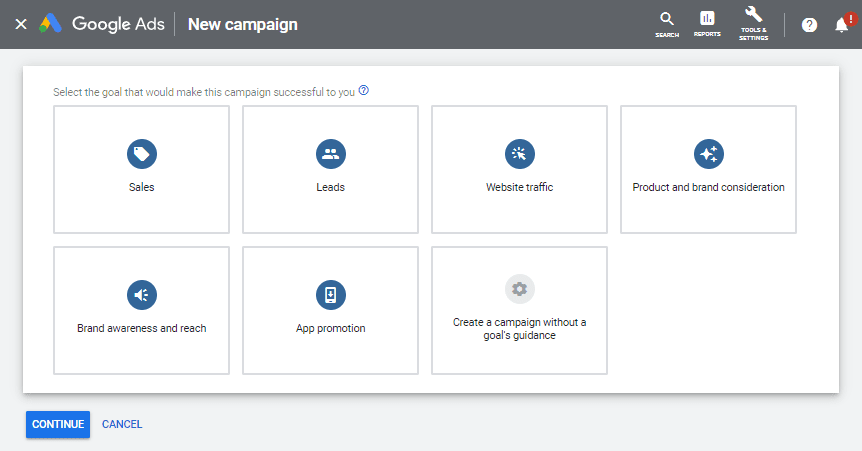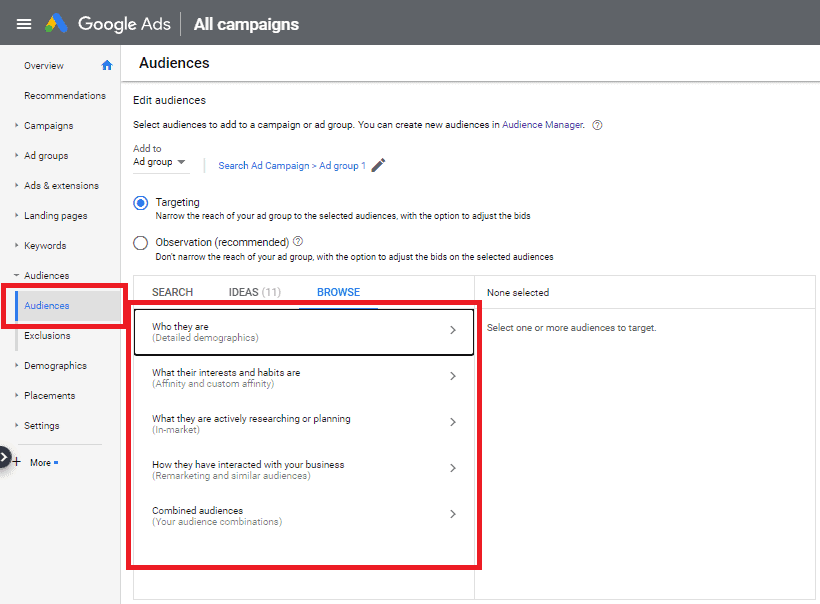Are you working on a PPC strategy that will help you dominate your competition in paid search and drive more revenue-generating traffic to your website than ever before?
Remember the difference between strategy and tactics in PPC: tactics are the specific techniques or methods used to accomplish an objective, while a strategy is an over-arching plan for coordinating these techniques in support of campaign goals.
Thanks to the rich feature set offered by Google Ads, digital marketers already have a broad range of PPC tactics available to them. There are loads of options for budgeting, audience and keyword targeting, bidding, ad creation, and landing page design – all of which play a part in overall campaign success. The role of a PPC strategy is to inform the coordination of these tactics and get them working together to maximize revenue while minimizing cost.
To help you get started, we’ve created this short guide on how to build a winning PPC strategy.
What is a PPC Strategy?
A PPC strategy describes the tactics you will use to optimize each element of your advertising campaign in a way that maximizes campaign revenue and return on investment.

Image Source: https://cdn.pixabay.com/photo/2016/03/06/17/41/business-idea-1240825_960_720.jpg
An effective PPC strategy has many different components:
- Setting campaign goals that guide strategic decision-making
- Choosing the right ad networks and management platform to support campaign goals
- Choosing the right PPC competitor research tool and leveraging it to identify and exploit weaknesses or gaps in your competitors’ strategies
- Setting a campaign budget that acts as a constraint on spending
- Targeting the most relevant keywords and bidding on them profitably
- Targeting the right audiences to capture the most relevant traffic
- Creating ad copy and messaging that is appealing to your target audience
- Using compelling offers and ad extensions to drive click-through rate (CTR) as you win ad impressions
- Building targeted landing pages that drive conversions from relevant visitors
The purpose of an effective PPC strategy is to get all of these components working in unison to maximize the results of your advertising campaign.
Why is PPC Strategy Important?
Imagine that you’re an offensive coordinator on your favorite NFL football team.
Your team’s playbook includes hundreds of different plays. A play describes a specific movement pattern for players and a distribution pattern for the football that helps advance the campaign objective – moving down the field toward the end zone.
These hundreds of plays are all of the tactics that you have available, but during a game, you don’t simply open up to a random page and say “Okay, let’s run this play.” This is where strategy comes in to play.
Before each game, you sit down to compare the strengths and weaknesses of your team with those of the upcoming opponent.
By identifying their weaknesses, you can begin to understand which of your tactics might be most effective against the opposition.
Having done so, you come up with a strategic plan for the game. You select tactics for the game that emphasize your strengths and expose the weaknesses of the opponent. As a result, you significantly increase your chances of success.
In the same way, digital marketers building a PPC strategy review their own marketing strengths and weaknesses, then gather data and insights on their PPC competition to discover the best opportunities for successful advertising plays.
This process informs how tactics like keyword targeting, bidding, audience targeting, ad messaging, and landing pages will be coordinated to achieve the maximum impact on campaign goals.
PPC Strategy & Quality Score
The coordination of your advertising tactics has a massive impact on the overall success of your campaign, especially through a mechanism known as Ad Quality Score.
Quality Score is Google’s way of quantifying the relevance of your ad copy and landing pages to the keywords and audiences you are targeting. A high-quality score means that audiences are more likely to click on your ad after searching for a specific keyword.
On the Google Ad Network, ads with a higher quality score are entered into more keyword options and enjoy higher rankings and lower CPC – all leading to increased profitability. High-quality scores are the product of an effective PPC strategy that connects relevant audiences with relevant search queries to highly targeted offers and landing pages.
Great PPC Strategy = Effectively Coordinated PPC Tactics = High-Quality Scores = More & Better Ad Placements, More Clicks, Lower CPC = Campaign Success & Profitability
Components of a PPC Strategy
We have already listed the many different components of an effective PPC strategy. Now, let’s take a deeper look at some of these elements and how they come together as part of a cohesive PPC strategy.
Campaign Goals
Campaign goals are the guiding light for your PPC strategy.
Whether your campaign focus is to elevate brand awareness, generate leads, drive more traffic to your website, or increase sales, setting goals will help you build a PPC strategy that sets you up for success.
Starting your PPC campaign without a goal is like setting sail without a destination. You’ll certainly get somewhere, but you’re less likely to achieve the outcomes that your business needs to be successful.

Image: When launching a new campaign in Google Ads, you’ll be prompted to set a goal that would make your campaign a success.
PPC Advertising Networks & Platforms
As part of your PPC strategy, you should consider which advertising networks you wish to target.
You may choose to run display ads on the Google Display Network or paid search ads on the Google Search Network.
You may also wish to run ads on other search engines, including on Google Search Partners or with Microsoft Advertising on the Bing and Yahoo search engines.
Social media advertising is also an option, with platforms like Facebook, Instagram, and LinkedIn all offering access to their audiences for advertisers.
PPC Competitor Research Tools
Competitor research is a critical aspect of your overall PPC strategy.
PPC competitor research tools give digital marketers the opportunity to see exactly how their PPC competitors are managing campaigns, from the keywords they’re targeting to the specific ad copy, images, and landing pages they use to drive campaign success.
With PPC competitor analysis, marketers can replicate the best tactics that are working for their competitors, discover new keywords to target, and identify the best opportunities to drive PPC campaign success.

Image: Competitor analysis software like SpyFu shows you which keywords your competitors are targeting and helps you identify opportunities they may have overlooked.
Campaign Budget
Campaign budgeting is another key component of your PPC strategy.
Because every click that your campaign generates costs you money, your campaign budget has a direct impact on your ability to meet business objectives.
If your budget is relatively small, you may wish to narrow the scope of your campaign and focus on audiences that are most likely to convert, such as remarketing audiences.
If your budget is larger, you’ll have more flexibility to target more keywords and experiment with different audiences and bidding strategies.
Keyword Targeting
Keyword research in PPC is all about targeting the search queries that are most likely to result in a conversion.
There are two key components here:
- Targeting “buying” or “bottom-of-funnel” keywords that reflect purchasing intent.
- Aligning keyword targeting with the content of advertisements and landing pages.
Audience Targeting
Audience targeting is one of the most powerful tools available to advertisers when it comes to optimizing PPC strategy.
Using Google Ads, digital marketers have near-limitless options for how they may configure audience targeting. Users can be targeted based on their past browsing behaviors, demographic data, recent search history, and numerous other factors.
Again, advertisers need to customize their audience targeting to ensure that ads are presented in contexts that are likely to result in conversions. That means achieving alignment between keyword targeting, audience targeting, ad copy, and landing pages.

Ad Copy & Messaging
Effective messaging and audience targeting go hand-in-hand as part of your overall PPC strategy.
The ability to target audiences based on very specific criteria means that you can deliver highly targeted ad copy with messaging that is contextualized, personalized, and ultra-relevant.
Achieving that perfect alignment between your audience and your advertising message results in high CTR, high-quality scores, better conversions, and strong overall campaign performance.
Ad Extensions
Ad extensions are an increasingly important strategic element in advertising campaigns.
Ad extensions are add-ons for paid search advertisements that give you more real estate on the page and give your audiences more ways to engage, often resulting in more clicks and better conversion numbers.
If your campaign goal is to generate leads, using the Call Extension allows audiences to quickly contact your business upon viewing your ad.
If your campaign goal is to drive website traffic, the Sitelink Extension might work better for you. This extension lets you present more links to different pages of your website as part of the same advertisement and has been reported to increase CTR by as much as 8%.
Landing Pages
Landing pages are the final step in your PPC advertising funnel.
Landing pages should always be chosen or designed to support your campaign objectives, encouraging visitors to fill out a lead form, submit contact information, or purchase a product (depending on your goals).
The best digital marketing experts in PPC build and customize individual landing pages for specific audiences, again striving to maximize the alignment between audience targeting, ad copy, messaging, and offers.

Image: Advertisers can build and deploy landing pages at scale using a software tool like Unbounce.
Summary
Thanks for checking out our PPC strategy guide for building an advertising plan!
You may have already been familiar with many of the campaign elements and tactics we described here, but PPC strategy is really about combining those elements in a way that produces cohesive experiences for the target audience and drives campaign goal attainment.
Remember, PPC strategy doesn’t end with the launch of your campaign.
You should also think about how you’ll collect campaign performance data and how you’ll use that data to optimize the performance of your campaign. This could involve changing your campaign tactics or strategy, or using conversion rate optimization (CRO) tools to boost the performance of your landing pages. Reach out to Directive’s PPC experts to take your marketing on pay-per-click advertising networks to the next level.
We hope this guide helps you develop a strong, unified PPC strategy for your upcoming PPC ad campaigns!
-
CEO Garrett Mehrguth
Did you enjoy this article?
Share it with someone!
